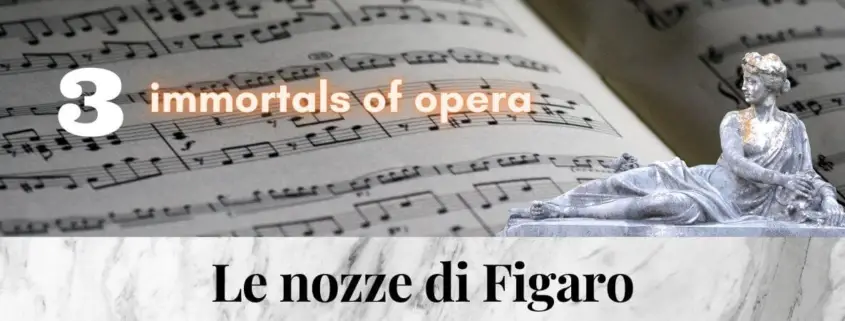3 immortal pieces from the opera LE NOZZE DI FIGARO by Mozart – with the best interpretations from YouTube (Hits, Best of)
The fact that Da Ponte and Mozart were able to form a masterpiece out of this intricate comedy borders on a miracle. With “Le nozze di figaro” Mozart not only wrote marvelous situational comedy with stunning music, but also five immortal role portraits for the main characters.
The Lonely Countess
In this aria, the Countess misses the times when the Count loved her dearly. Undoubtedly, “Porgi amor” is one of the highlights of the opera and one of the most beautiful lyrical pieces written for soprano. The music is set in major, although the Countess’s mood is sad and contemplative, this is perhaps even the charm of this piece. The aria begins in piano and culminates in the middle, with the heartbreaking death wish “o mi lascia almen morir” repeated twice, accompanied by the unearthly, painful cantilena of the clarinet. “Porgi amor” is the first appearance of the Countess. She is alone on stage and she has to sing the most beautiful aria of the opera right away, some singers have respect for this aria because of that. Otherwise, there are no major vocal difficulties, it is a simple cavatina and its duration is comparatively short. But as always with Mozart, the simple things are the most difficult.
In the playlist you will find three versions of this aria.
First, listen to this aria in a wonderful, melancholy, unbeatable interpretation by Elisabeth Schwarzkopf. Every word is given a beautiful tone color. The breathing is imperceptible and allows the music to shine with beautiful long phrasings.
Porgi amor – Schwarzkopf.
Cherubino’s Aria “Voi che sapete”
Cherubino is a trouser role for a young soprano. He is the Count’s pageboy and at an age when emotions are awakening. The song is a sung declaration of love by an adolescent to all women. Mozart composed this touching scene in a naive, childlike tone. The aria opens with a graceful melody accompanied by syncopated violins imitating a guitar played by Susanna. As time passes, the music becomes more intense. Mozart modulates the melody in small steps, evoking a passionate, mounting mood and giving the person of Cherubino an otherworldly glow.
Magically and hypnotically sung by Maria Ewing in Ponnelle’s film version.
Voi che sapete – Ewing.
“Che soave zeffiretto”: a great duet of Susanna and the Countess
“Che soave zeffiretto” is perhaps the most beautiful duet Mozart wrote. The Countess and Susanna write a letter to the Count inviting him to a rendez-vous “in the pines of the grove, where a gentle evening wind blows.” Mozart captured the mood of this gentle evening wind in a wonderful way. In this tender duet, the two voices are enchantingly accompanied by oboe and bassoon.
Listen to this duet in the wonderful interpretation of Elisabeth Schwarzkopf and Irmgard Seefried. Of Seefried in this 1953 recording under Furtwängler, Kesting says: “If one wants to feel something of the soulful effect of her singing, one must listen to the early recordings … she has in Schwarzkopf a partner who comes as close to perfection as is possible.”
Che soave zeffiretto – Schwarzkopf / Seefried







Thank you for this piece. I’ve head Voi Che Sapete many times not knowing from where, nor from who it was from.